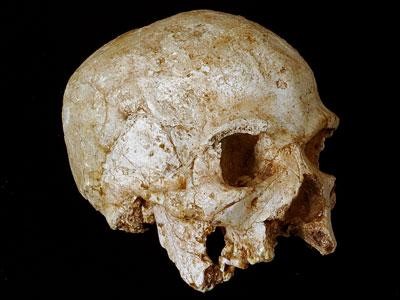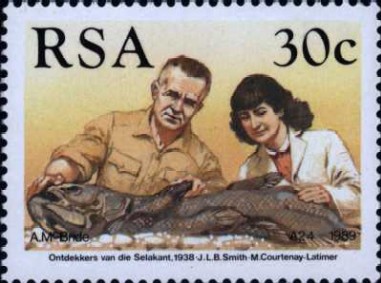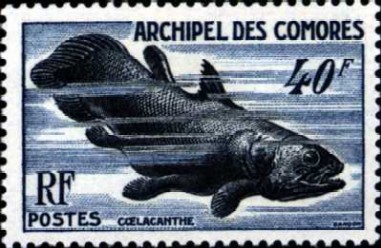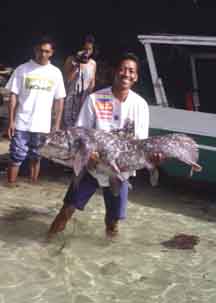Coelacanth Quickies: Hofmeyr and Mount Karthala
Posted by: Loren Coleman on January 21st, 2007

Coelacanth tidbits have been surfacing and leaping up into my awareness over the last few days. I’ve fished them out of my short term catches and netted them anew here for you.
1) A highly debated bit of hominid fossil news these days is focussing on the Hofmeyr skull. The skull, found 55 years ago in a river bed near Hofmeyr in the Eastern Cape Province, South Africa, has resurfaced because of a new analysis of the contents of the inside of the skull. This new study has shown that the Hofmeyr skull is a lot older than people thought. An article in Science, January 12, 2007, details the findings.

The Hofmeyr skull (above). Scientists have now dated the skull as being 36,000 years old. The great similarity of this skull to skulls of the same age from Eurasian finds allegedly confirms the “Out of Africa” hypothesis. Modern humans broke out of their place of origin around 40,000 years ago — from Africa south of the Sahara — and populated the world, according to the Science paper.

Now here’s the coelacanth link to this possibly ground-breaking fossil find: The skull was found in 1952, by none other than Marjorie Courtney-Latimer (above, left) – the museum curator who discovered in 1938, the first coelacanth and was honored with having her name forever linked to it (Latimeria chalumnae). Since the second coelacanth was not found until 1952, the same year of the Hofmeyr skull find, her skull discovery that year has always been overshadowed.

2) The oceans around the location of where the 1952 coelacanth was found and the Comoros islands most associated with coelacanths were rocked on January 18, 2007, by earthquakes. Comoros’ largest island shook twice and there is a threat of eruption from Mount Karthala, one of the world’s largest active volcanoes. Comorian authorities have made emergency plans to evaluate at least 30,000 people in case the 7,746 ft (2,361 meter) volcano, which dominates the main island of Grand Comore, blows.
3) Finally, Dinofish’s Jerome Hamlin is on his way this winter to check out some tantalizing rumors from an undisclosed location for what may be a new population of coelacanths. Stay tuned.

The first Indonesian coelacanth captured by locals on the team headed by scientists Mark and Arnaz Mehta Erdmann, who described the discovery in the September 24, 1998 issue of Nature. If Indonesia, why not elsewhere in the world?
About Loren Coleman
Loren Coleman is one of the world’s leading cryptozoologists, some say “the” leading living cryptozoologist. Certainly, he is acknowledged as the current living American researcher and writer who has most popularized cryptozoology in the late 20th and early 21st centuries.
Starting his fieldwork and investigations in 1960, after traveling and trekking extensively in pursuit of cryptozoological mysteries, Coleman began writing to share his experiences in 1969. An honorary member of Ivan T. Sanderson’s Society for the Investigation of the Unexplained in the 1970s, Coleman has been bestowed with similar honorary memberships of the North Idaho College Cryptozoology Club in 1983, and in subsequent years, that of the British Columbia Scientific Cryptozoology Club, CryptoSafari International, and other international organizations. He was also a Life Member and Benefactor of the International Society of Cryptozoology (now-defunct).
Loren Coleman’s daily blog, as a member of the Cryptomundo Team, served as an ongoing avenue of communication for the ever-growing body of cryptozoo news from 2005 through 2013. He returned as an infrequent contributor beginning Halloween week of 2015.
Coleman is the founder in 2003, and current director of the International Cryptozoology Museum in Portland, Maine.










I am always happy to hear new Coelacanth news, and I am curious about this “undisclosed location”. Now if we could only get something substantial about the possible Gulf of Mexico population!
It is “undisclosed” for a reason, of course. Stay tuned.
The Gulf of Mexico rumors were based on little silver coelacanths, which turned out to be post-1953. I won’t hold my breath on that population.
I am not holding my breath, either, but there were more little silver Coelacanths at other times (in different styles) and the purported scales from Florida as well, as Shuker reports on and as I am certain that you know as well. It is a nice thought, anyway.
I thought mettalurgical analysis of the votives proved them to have been made in the 1600’s by a particular mexican tribe? Were these disproven, or am I not remembering correctly? Methinks I need to brush up on my Shuker…anyone recall which of his books this was mentioned in? I want to say “Flying Frogs And Snakes With Wings”, but it’s been a while since I’ve read it.
As I mentioned, there are different silver Coelacanths in different styles. I do believe “From Flying…” was the Shuker book that discusses the matter, and I think he mentions those coelacanths on his extended checklist of unknown animals.
As another little-known sidelight on this confused issue, the ’60’s TV show the Outer Limits seems to have picked up on rumors of the Gulf of Mexico coelacanths/”fishes with legs” and made them the monsters in one of the episodes, only it called them “Ichthiosaurus mercutius” and showed them with frog’s legs: that episode had little clay “ancient native art representations of the monsters” as well. It was one of their first season episodes called “Tourist Attraction”
On Checking Shuker:
The matter is mentioned in his checklist, which is printed in his book The Animals that Hide from Man, and referring back to his earlier book Prehistoric Survivals. He also mentions Raynal as a source (Raynal has different little silver coelacanths in mind than the ones Shuker illustrated) and a possible location of more coelacanths around Easter Island.
This is “on the books” as the saying goes.
The other book’s title is actually “From Flying Toads to Snakes With Wings” and it mentions the Comoro Islands coelacanths but “no other ones known” at that point.